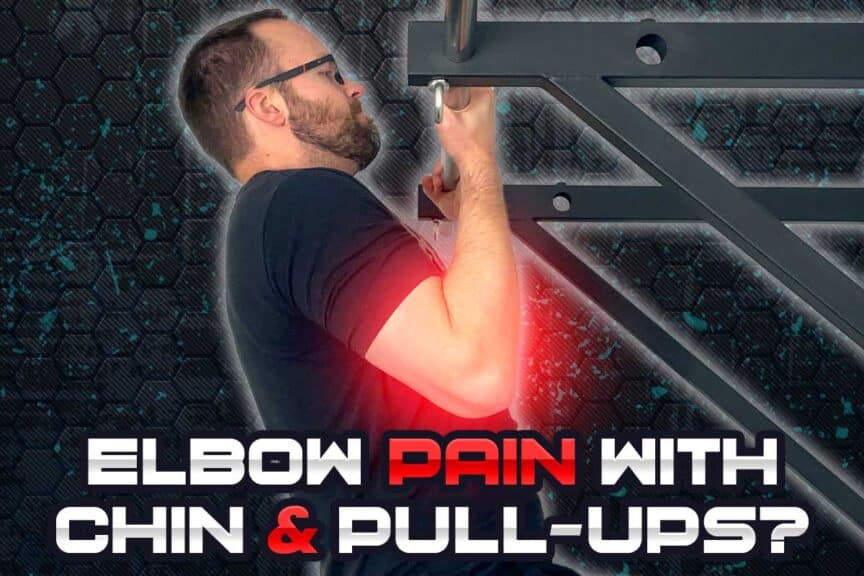Chin-ups and pull-ups are staples for upper-body strength training. Of course, you likely already know that; otherwise, you wouldn’t be here right now. Chances are, you’re here because of some nagging pain in your elbow you’ve been experiencing when performing either of these exercises (but if not, thanks for checking out this article anyway!).
Don’t worry; I’ve got you covered for what’s likely going wrong in your elbow and what it will most likely take to get things back on track.
Elbow pain from chin-ups and pull-ups can be multi-factorial and often arises from poor technique or poor mobility around the joint. It can lead to tendon issues (such as golfers or tennis elbow), issues within the elbow joints (often the humeroradial joint), or within muscles themselves.
So, let’s unpack what’s going on here with this common elbow issue so that you can get back on track with your upper body exercises.
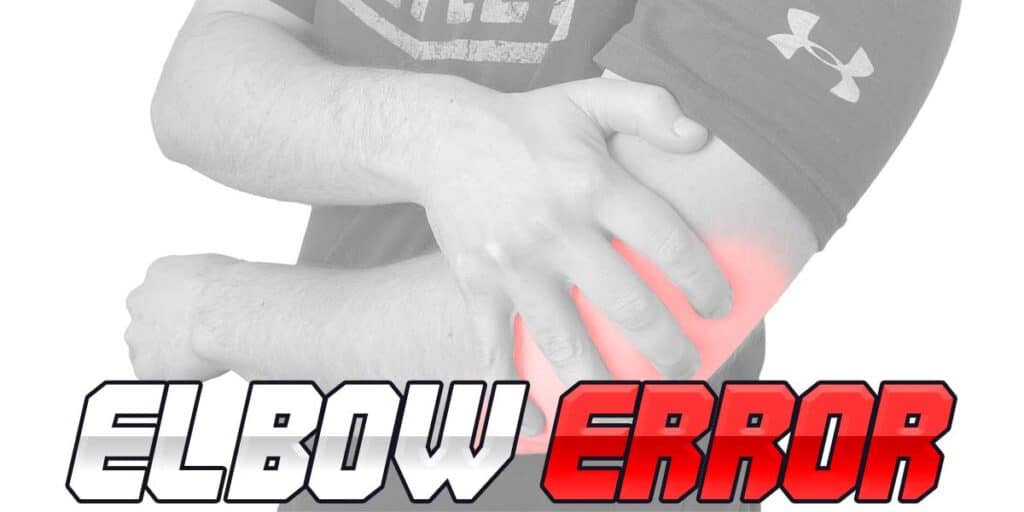
Related content:
Basic elbow anatomy
As with nearly all of my other blog articles that involve fixing pain from a particular exercise, I believe it’s best to begin with a brief rundown of the involved anatomy.
A basic understanding of the tissues and structures in the area (and how they are designed to operate) will make your recovery process much more intuitive. This, in turn, will optimize your overall recovery by speeding up the healing process while ensuring a more complete healing response.
Taking a bit of time to become educated on an injury is one of the many proven steps it takes to become the best athlete that you can possibly be. So, be disciplined and read this section.
Joints of the elbow
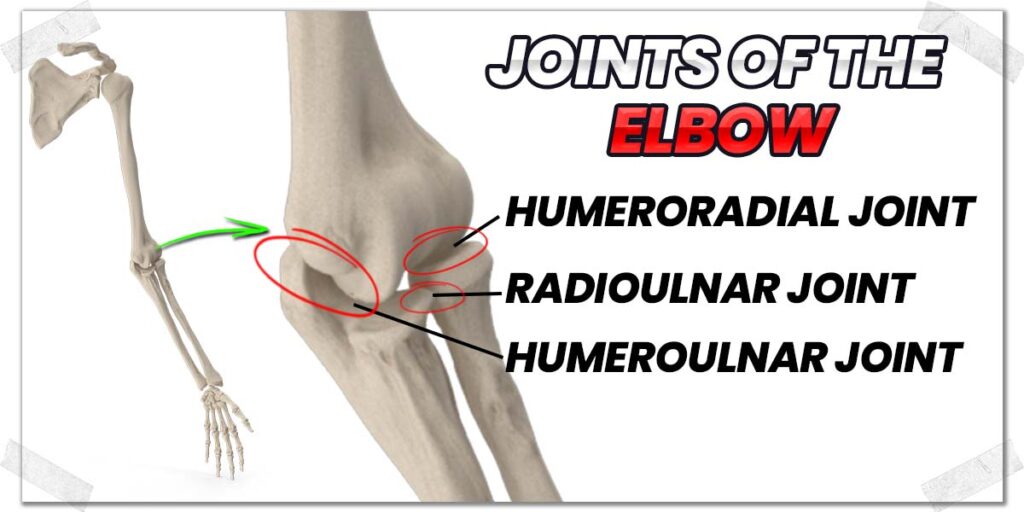
The elbow itself actually consists of three individual joints:
- The humeroulnar joint
- The humeroradial joint
- The radioulnar joint
The humeroulnar joint is the one most individuals are familiar with; it is the hinge joint that allows the elbow to straighten and bend (extend and flex, respectively).
The humeroradial joint works in conjunction with the humeroulnar joint, helping to bend and straighten the elbow.
The radioulnar joint is the interface of the radius and ulna. The articulation of this joint permits us to rotate our palm downward (known as pronation) or upward (known as supination).
Restrictions in any of these joints can lead to elbow pain. As you’ll soon read, the hand position (underhand or overhand) when pulling yourself upwards can place an increased or decreased amount of stress on the joints. When any of these joints are restricted (not moving as ideally as they should), it can lead to abnormal stress and strain on that particular joint.
Pro tip: Chin-ups require a fully-supinated grip, which can be taxing on the radioulnar joint, especially if you have poor shoulder mobility. Solution 1 of this article will show you a quick fix for this issue.
Muscles of the elbow (for chin-ups and pull-ups)
While there are a handful of individual muscles that cross the elbow joint, the main ones to be aware of for this article are:
- The biceps muscle (biceps brachii)
- The forearm flexor muscles (located on the inner side of the elbow)
- The forearm extensor muscles (located on the outer side of the elbow)
- The supinator muscle
Each of these muscles (or groups of muscles) experiences an intense demand when performing chin-ups and pull-ups. As such, they can often become overworked (either from a single workout session or from the culmination of multiple sessions). This can lead to annoying and painful conditions such as tendinopathy, which you’ll learn more about in a moment.
The solutions presented later in this article are designed to help with these issues, so you’re going to want to keep reading.
Common issues that lead to elbow pain
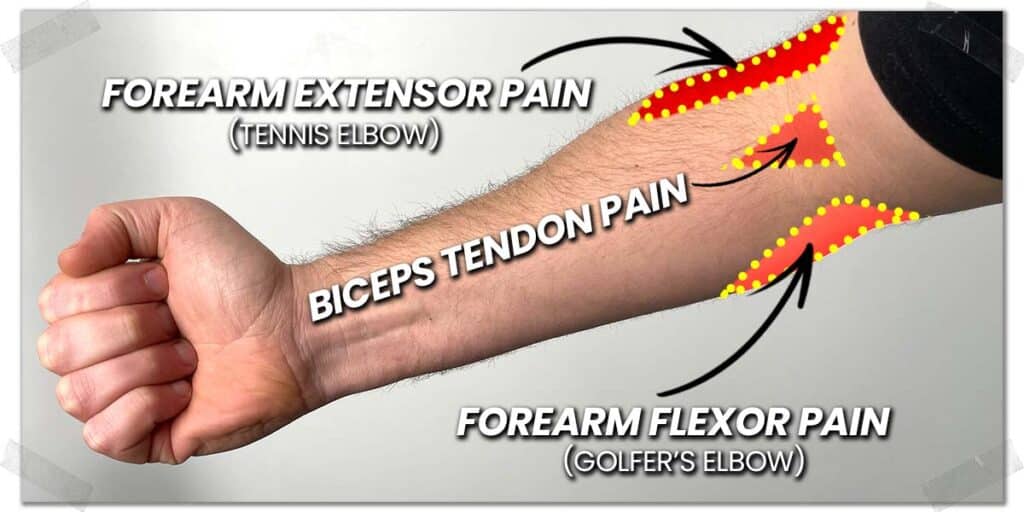
There are multiple reasons why elbows can become sore, irritated or even painful when (or after) performing chin-ups or pull-ups. I certainly can’t cover them all within a single article. I can, however, cover the common issues that are seen frequently in the physiotherapy clinic where I work.
What follows below are the common issues that arise when performing chin-ups (using an underhand grip) and pull-ups (using an overhand grip). Some issues are largely mutually exclusive, while others can occur regardless of the grip (hand position) that’s used.
Common elbow issues from an underhand grip (chin-ups)
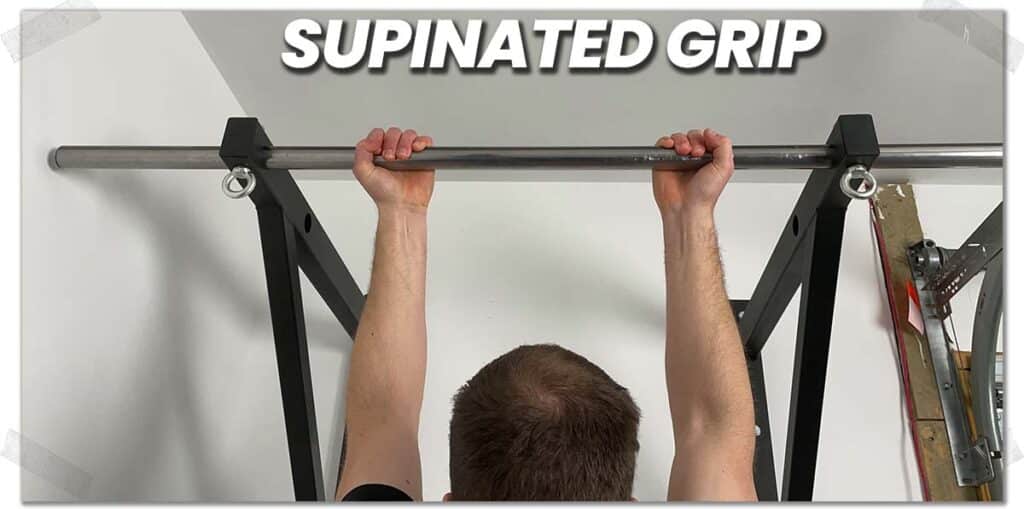
Chin-ups present a unique challenge to the elbow due to the extreme/higher amount of supination (rotating the palm upwards) the forearm must go in order to grab onto the bar. As such, they demand a greater extent of joint mobility from the shoulder joint and the radioulnar joint.
Read on to learn the specifics!
Joint restriction
The underhand grip (used for chin-ups) requires an adequate amount of shoulder joint mobility (to rotate the upper arm outwards) as well as radioulnar mobility (to achieve supination). When either (or both) of these joints can’t move into their required range of motion, it can lead to stress (torque) in the elbow since the palm must be fully supinated to grab onto the bar.
This is essentially the same reason why individuals often experience wrist pain with biceps curls when using a traditional bar.
As such, when using an underhand grip, the actual cause of elbow pain can, in fact, be due to poor shoulder mobility. This is a classic example of how the location of one’s pain isn’t always where the actual cause is.
Flexor tendon overuse
The supinated (underhand) position can also be fairly taxing on the flexor tendons of the elbow, particularly at their origin, which sits just above the elbow joint itself. Irritation or overuse of these flexor tendons can lead to golfer’s elbow, otherwise known as medial epicondylalgia (a form of tendinopathy around the elbow and forearm) (This is a condition I am all too familiar with myself).
Tendinopathy is an umbrella term that refers to a generalized unhealthy state of a tendon (or group of tendons). It tends to present as a dull, achy pain that worsens when those tendons experience mechanical demands (such as exercise) beyond what they can adequately tolerate.
Keep in mind: The extensor tendons on the outside of the elbow) can still become irritated with the underhand grip. However, extensor tendon issues are more commonly felt during pull-ups (discussed in a moment).
Biceps tendon stress
The biceps muscle inserts between the radius and ulna, just below the elbow joint, via a thick common tendon.
What very few fitness goers (and even die-hard lifters) are unaware of is that the biceps muscle is the primary muscle responsible for supination; many are aware that this muscle bends the elbow but don’t realize it also is what primarily works to turn your palm upwards (crazy, eh?).
So, when in a fully supinated (underhand) position, such as with chin-ups, the biceps muscle (and its common tendon) is in a shortened and tense state. This usually isn’t a big deal for an otherwise healthy biceps tendon. But…
If the biceps tendon is unhealthy (typically due to a condition such as tendinitis or tendinosis), the high amount of force or demand the tendon experiences (due to the subsequent pull it receives from the contracting biceps muscle when pulling the body upwards) can be very irritating on the tendon itself.
This is why a neutral-grip pull-up or an overhand-grip pull-up is often preferred by lifters and athletes dealing with biceps tendon pain; these two grip positions are much less aggressive on the distal (common) biceps tendon.
Offloading the biceps tendon is your first step to take here, which can be done either by switching to the neutral-grip or overhand-grip position. Solution 1 (next section of the article) is going to show you a super practical way to achieve this outcome.
Common elbow issues from an overhand grip (pull-ups)
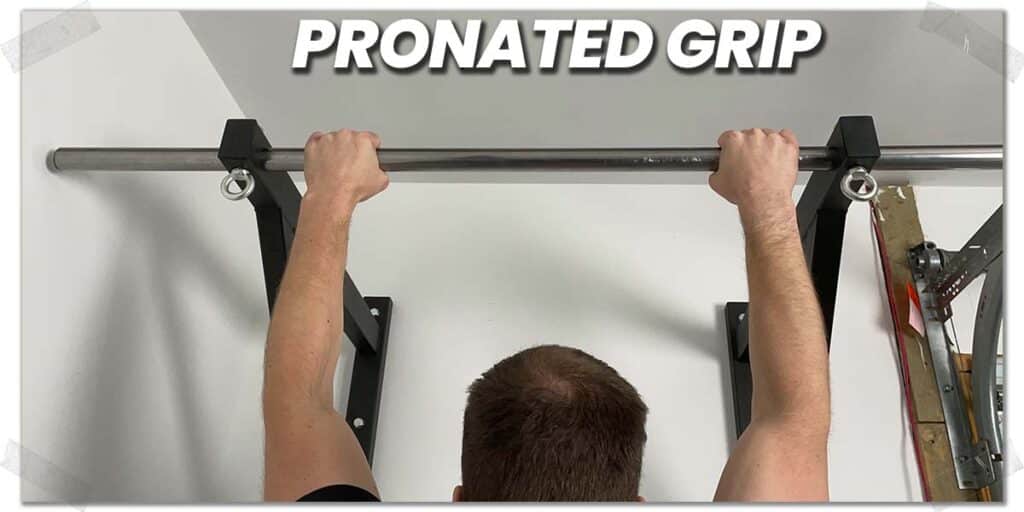
The overhand grip is used for pull-ups, and just like the underhand grip, it can lead to its own unique set of problems. The most common issues are listed below.
Extensor tendon overuse
The overexertion or overuse of the extensor tendons is the main elbow issue to look out for when using the overhand grip for pull-ups.
These extensor muscles originate on the outside edge of the elbow just above the joint and run down the back of the forearm into the hand and fingers. Their role is to extend (straighten) the fingers and the wrist. When in a pronated position, such as with pull-ups, the upper portion of these muscles (near the elbow) experience a bit more tension than with the underhand grip. As such, they’re prone to becoming strained or overworked.
Related article: Why You Have Sore Abs From Pull-ups (What it Means & How to Fix it!)
The result can be an annoying, stubborn and even painful elbow issue known as tennis elbow (lateral epicondylalgia). It’s the same type of issue as golfer’s elbow but just with the opposite set of muscles on the other side of the elbow.
Solution 1: Use rotating handles
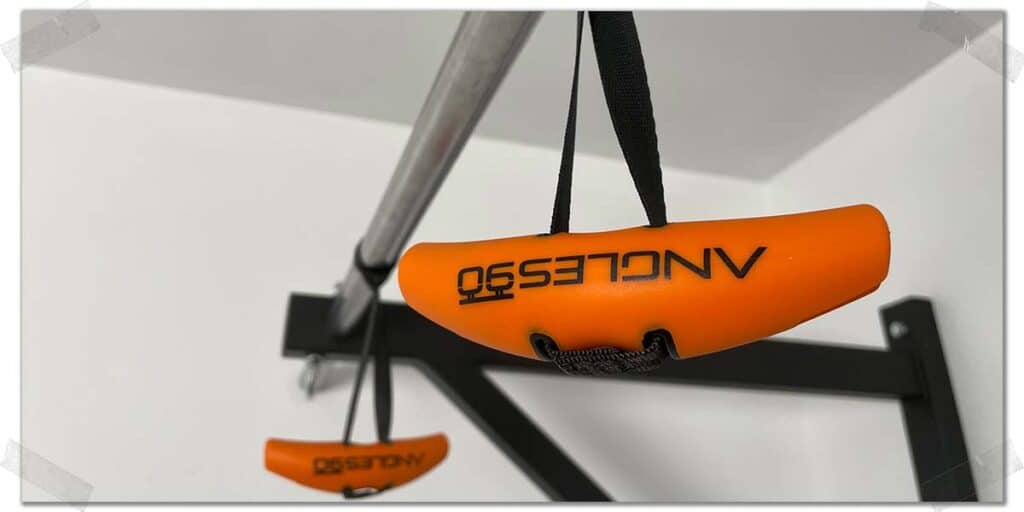
If your elbow pain is due to sore elbow joints or poor external shoulder rotation mobility, chin-ups and pull-ups can place an abnormal torque on the elbow joint. Thankfully, if your pain is solely from this issue, it can typically be cleaned up almost instantly.
The solution here (assuming you don’t want to forego chin-ups and pull-ups for different exercises) is to consider performing the exercise in a way that permits you to complete the movement while allowing your shoulders and elbows to freely move into more accommodating positions while avoiding ones that are less-provoking.
Rotating handles are an ideal way to let your joints move freely throughout the exercise. While a traditional stationary chin-up or pull-up bar won’t allow this, you can easily sling some handles over the bar to open up a whole new world of grip positions for your exercises.
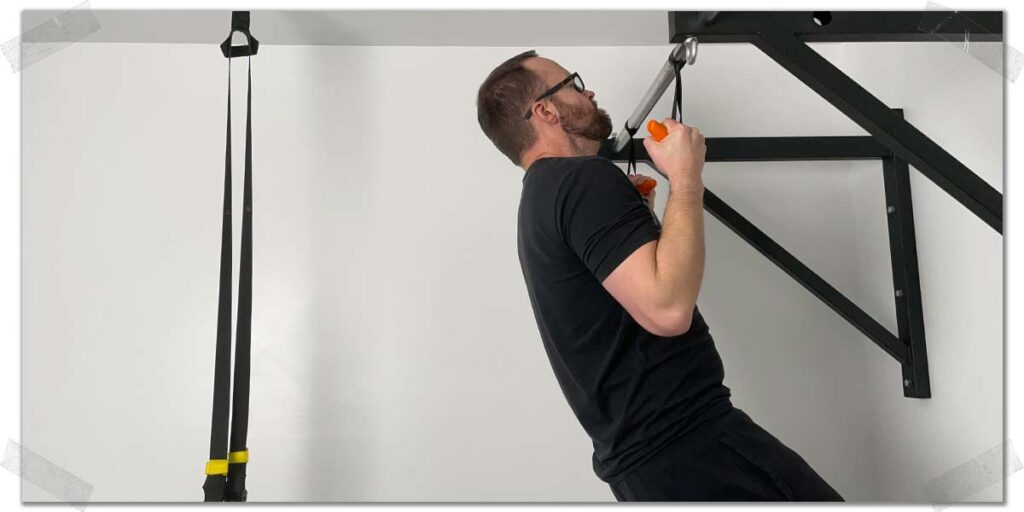
This will allow you to use an overhand, underhand, neutral grip, or even an accommodating grip (a grip position that changes throughout the exercise based on your needs – typically from an underhand to a neutral grip).
Angles 90 are my favorite way to do this. While numerous other knock-off versions are on the market, the Angles 90 have an outstanding reputation and are versatile enough to be used for a wide variety of additional pulling exercises aside from chin-ups and pull-ups. (Each handle is rated to hold up to a 400-pound capacity).
FYI: You can use the Angles 90 with different pieces of equipment; they’re not just for pull-ups and chin-ups. You can essentially use them with almost any type of pulling exercise you can think of!
If, however, you find that it’s still a bit too painful to perform your chin-ups or pull-ups, you can try lessening the intensity by using a TRX for injury recovery, which will allow you to perform the same pulling-based exercise (while using rotating handles) but with reduced muscular and joint stress.
Using a neutral grip
If picking up some handles isn’t in the cards for you, your next best bet might be to find a chin/pull-up bar that allows you to perform the exercise with a neutral grip (palms facing one another).
These types of bars are the ones that are typically seen on the top of squat cages, where they have handlebars running parallel to one another, allowing you to grab onto them via a neutral grip.
The downside is that you’ll need a bar with parallel handles – something you might not have access to. This is why I find it easiest to just pick up some handles (I can use them at home or take them to the gym).
Solution 2: Try modifying your range of motion
This solution might be a quick fix if you find that your elbow pain is only present (or most prominent) at the bottom of the movement (i.e., when your arms are straight/near straight before pulling yourself upwards).
Pain experienced near or at the bottom of the chin/pull-up is often due to the intolerance of irritated or unhealthy tendons undergoing the extensive stretch they’re experiencing.
For chin-ups, this most often includes:
- The distal biceps tendon (also known as the common biceps tendon)
- The forearm flexors
- The pronator teres
For pull-ups, this can often include:
- The forearm extensors
As a result, it may be worth temporarily shortening your range of motion while you work on resolving your elbow pain. The best way to do this involves performing your chin/pull-ups through as much of a pain-free range of motion as possible.
This will allow you to keep performing the exercise but without likely further irritating any unhealthy tendons in the process.
Note: This strategy is likely only practical if you have to sacrifice a relatively smaller range of motion; performing chin/pull-ups in which you only bend and straighten your elbows by a few degrees won’t lead to any appreciable benefits in your strength or athletic abilities (but I suppose something is better than nothing).
Solution 3: Lighten the load with resistance with bands
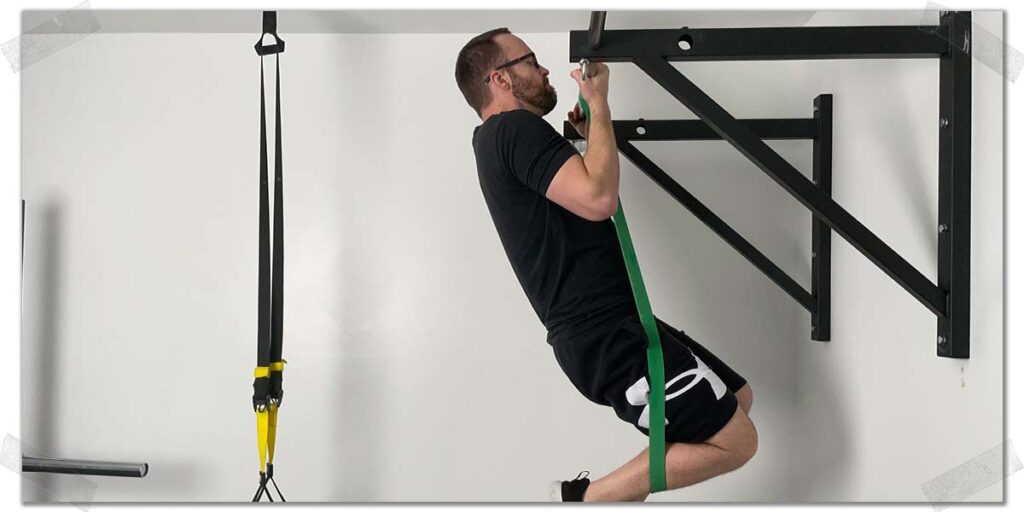
As with solution 1, this strategy may be worth trying if you are as keen as possible to keep performing your chin-ups or pull-ups without having to forego them or switching to a replacement exercise. These are otherwise known as band-assisted chin-ups or band-assisted pull-ups.
Using a resistance band can substantially decrease the amount of resistance and force your elbow and subsequent muscles and tendons are exposed to during the exercise.
As such, it will likely work best for those who notice they experience elbow discomfort when performing chin-ups or pull-ups but not necessarily on other pulling-based exercises at lighter intensities (such as rows or lat pulldowns).
If this applies to you, simply select an exercise band that provides the minimal amount of upwards assistance required when pulling upwards to make the exercise pain-free.
Pro tip: if you haven’t used one of these giant bands before, they’re easy to find online or at fitness stores. The wider the band, the more “spring” it will provide when pulling yourself upwards.
Solution 4: Try eccentric chin-ups/pull-ups
If your elbow pain arises (or is most notable) when pulling yourself upwards, it may be worth trying eccentric chin-ups or pull-ups. The eccentric phase of either of these exercises refers to the phase of the exercise where you lower yourself down (slowly) to the starting position (the upwards pulling phase is known as the concentric phase).
Eccentric exercises often work exceptionally well for improving the health and strength of unhealthy tendons. As such, if you’re confident your elbow discomfort is tendon-based (from the forearm flexors, extensors, or common biceps tendon), performing the eccentric-only version of chin/pull-ups can be quite therapeutic and an effective way to rebuild strength and capacity within the tendon(s).
Pro tip: Experiencing a mild discomfort in the affected tendon(s) typically isn’t a bad thing, so long as it’s mild and doesn’t worsen throughout the process. Pain, however, should be avoided.
How to perform eccentric chin-ups and pull-ups
The easiest way to try eccentric chin/pull-ups is to place an object, such as a step stool or box (such as a plyometric box), underneath the bar. Ideally, the platform should be high enough so that you don’t have to perform a big jump as you hop up to the top of the pull/chin-up position (chin either at or above the bar).
From there, slowly lower yourself down to the bottom position so that your arms are either straight or near-straight. This should be a pain-free process; if something hurts, these eccentrics might not be appropriate.
Slow eccentrics are a proven and outstanding way to increase muscle strength and tendon health.
As a general rule, try to make each downward repetition last between five to ten seconds. You shouldn’t need to perform any more than ten repetitions before your muscles feel noticeably exhausted. You can perform a couple of sets if you’d like. Just pick what’s most ideal for you.
Solution 5: Switch over to rowing exercises
If chin-ups and pull-ups are so painful that they’re out of the question for you (or if you’re just as happy to perform a different exercise that targets the same muscles), opting for different rowing-based exercises or pulldown exercises is a smart move to make.
Numerous pulling-based exercises will train the same set of back and arm muscles as pull-ups and chin-ups but perhaps without irritating or causing pain to your elbow(s) in the process.
This is predominately true regardless of whether you perform vertical pulling exercises or horizontal pulling exercises. There will be some differences, but they’re still more similar than they are different.
Performing dumbbell rows
A good starting point would likely be to try dumbbell exercises, such as dumbbell rows. The reason is: when you hold onto a dumbbell, the upper arm can freely rotate, allowing any restriction or tightness in the shoulder joint to be avoided (i.e., your hand won’t need to be in a fully supinated position).
As a result, it’s less likely that your elbow will experience any torque from the forearm needing to be in a fully supinated (underhand) position while the upper arm bone (the humerus) wants to stay rotated inwards.
You can, of course, still perform barbell rows; however, you may want to avoid the underhand grip and instead use an overhand grip. Or, you could even hook up the Angles 90 (or similar) straps to the barbell and hold onto those during the exercise.
Performing lat pulldowns
If you’re keen on replicating the pull-up or chin-up movement as much as possible, your best bet is to try lat pulldowns. They’re the same movement, but instead of pulling weight upwards, you’re pulling it downwards.
The beauty here is that you’ll have some added variety to play around with; you can try overhand or underhand grips with the pulldown bar, you can use a V-handle, or even perform single-arm pulldowns with a standard handle attachment.
The only downside here is that you’ll need a dedicated lat pulldown machine, which you might not have if you’re trying to workout at home.
Final thoughts
Elbow pain can be annoying and stubborn, and it’s certainly not worth trying to power through any aches and pains. But since chin-ups and pull-ups are such immensely beneficial upper-body exercises, it’s worth finding ways to perform them or, at least, replicate their demands without blowing up your elbows in the process.
So, take the insight in this article and use it as a generalized starting point to help get back on track to banging out pain-free chin-ups and pull-ups!
Frequently asked questions
I’ve included answers to a few commonly asked questions that active individuals often have regarding either chin-ups or pull-ups. I hope they help answer any additional questions you may have as it pertains to any elbow pain you’ve been experiencing.

Hi! I’m Jim Wittstrom, PT, DPT, CSCS, Pn1.
I am a physical therapist who is passionate about all things pertaining to strength & conditioning, human movement, injury prevention and rehabilitation. I created StrengthResurgence.com in order to help others become stronger and healthier. I also love helping aspiring students and therapists fulfill their dreams of becoming successful in school and within their clinical PT practice. Thanks for checking out my site!

